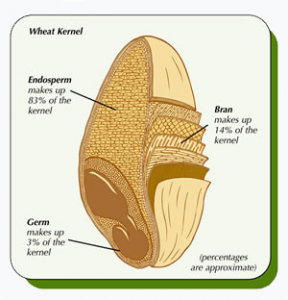Buying bread can certainly be confusing. There are tons of health trends that revolve around grains and bread. Hey! We also know that grains have been around for centuries- providing food for our human ancestors! There are even aisles dedicated to grains in your local grocery store – but which are the healthiest option? And/or most importantly what are the differences? Glad you asked! Whole grains contain the entire grain kernel. What makes a whole kernel so special is that each layer contains special nutrients that can provide the human body with an abundance of micronutrients! You can see whole kernels in grain products like Dave’s Killer Bread (sound familiar?)
If you  look at the kernel figure to your right, the outside layer of a wheat kernel is made of layers of bran—primarily hemicellulose, a nonfermentable fiber—making this whole grain a good source of fiber. The endosperm which makes up 83% of the kernel is the main part of the seed from which flour and meal are made. The Germ which makes up 3% of the kernel is the embryo that produces a new wheat plant. Yes—you can sprout or grow kernel seeds if it’s whole and organic!This can also add the needed micronutrients for your body. Whole grains are rich in fiber and fermentable carbohydrates, as well as antioxidants, trace minerals, and phytochemical—all have protective properties against cancer.
look at the kernel figure to your right, the outside layer of a wheat kernel is made of layers of bran—primarily hemicellulose, a nonfermentable fiber—making this whole grain a good source of fiber. The endosperm which makes up 83% of the kernel is the main part of the seed from which flour and meal are made. The Germ which makes up 3% of the kernel is the embryo that produces a new wheat plant. Yes—you can sprout or grow kernel seeds if it’s whole and organic!This can also add the needed micronutrients for your body. Whole grains are rich in fiber and fermentable carbohydrates, as well as antioxidants, trace minerals, and phytochemical—all have protective properties against cancer.
In contrast to whole grains, refined grains are kernel milled and separated from the bran and the germ leaving only endosperm. This commercial milling process or what I like to call “The Great Grain Robbery’ removes all the nutrients received from the Bran and the Germ. The sad truth is that food manufactures do something that defies logic: they refine grains, which removes the two most nutrition packed parts-the bran and the germ.
During this process, you can say farewell to the minerals, fiber, and antioxidants received from the bran and germ because once removed, it can no longer return to its original natural form.
Again, refined grains are simply wheat with all the good stuff taken out!
Think of wonder bread, white rice, and baked goods made with white flour. To counteract these losses in nutrition, within the United States, bread and cereal are made from milled grains and enriched with four B vitamins (thiamin, riboflavin, niacin and folic acid). This addition helps protect us from the common deficiency diseases associated with a dietary lack of these nutrients. Unfortunately, these products remain lower in other important micronutrients compared to whole grain products, such as whole-wheat bread and brown rice products.
Choosing the right product can be tricky. So here are a few guidelines that can assist in your daily grains intake. The best possible way to get your grains is for them to be intact! Whole grains such as brown rice, barely, millet, wheat, spelt berries, oat groats, and quinoa can be cooked as breakfast cereals, casseroles, soups, stews; or as pilafs. Other great minimally processed grains are: cut, rolled, or stone ground, with little or nothing added or removed. These methods of processing do little damage to the grain and you will get to intake all the important nutrients that comes from less refined grains!
In the end, if you are looking for the most complete form of nutrition that whole wheat and grains can offer, you can simply read the labels and learn what is in the bread you eat! My recommendation is when you are walking through the bread aisle in your local grocery store, search for the words “whole” and read the ingredients. Understand what is being offered to you and know what your body’s worth! Welcome the Whole Grains for Breakfast and say farewell to the wonder breads! Make sure to eat your variety of whole grains to ensure that your body is receiving the nutrients needed that promote a healthy lifestyle!